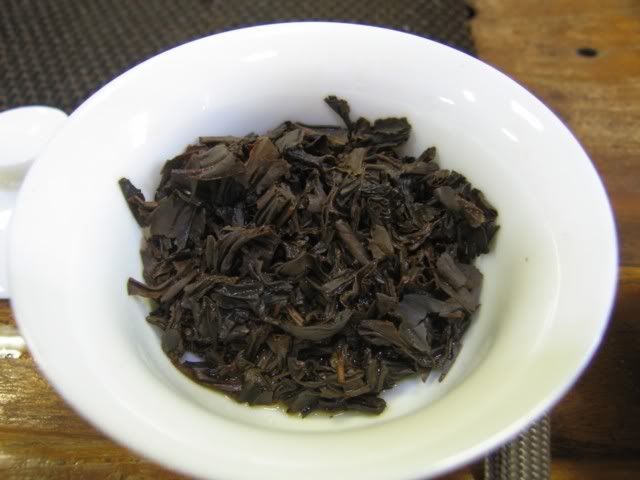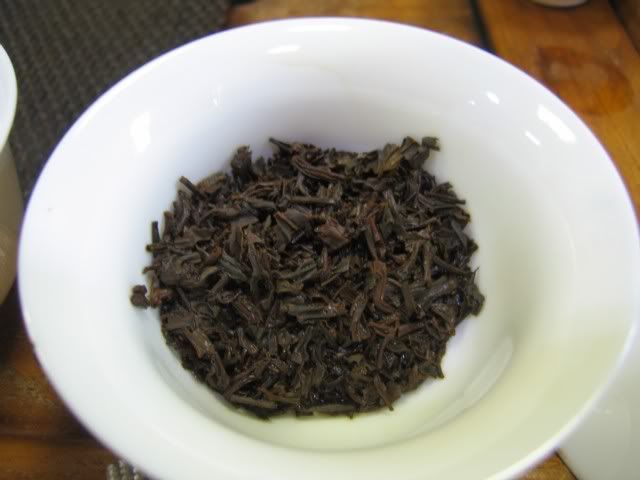I went to Maliandao today to buy some tea, and of course, during the course of the afternoon, I had a dizzying array of tea (when do I not when I’m there?). I won’t bore you with all the details of all the teas we had. Needless to say, it included a lot of puerhs… mostly Yiwu today.
But that’s not the interesting stuff.
I had a lesson in Zhengshan Xiaozhong (Lapsang Souchong) today. A valuable lesson that I will always remember. So, I figured this is a good thing to post about.
I will let the pictures speak for themselves

This is the fourth infusion of the teas above, but left and right are flipped around. So, the leaves on the right above brewed the tea on the left, and vice versa

This brewed the cup on the left

This brewed the cup on the right

I think it is not terribly obvious, but you can sort of see how in the brewed up… the right hand cup is slightly darker. The first two infusions were largely identical… it’s extremely difficult to figure out which one is better, even when drunk back to back and right by each other. I couldn’t for the life of me figure out how they can be 40% different in price. The second infusion… you can sort of tell the one with smaller leaves (buds) is a little more complex… but it’s a very faint difference.
Then from the third infusion onward the difference became clearer… the flavour for the buds was sustained, whereas the one with the leaves started feeling a little watery. Then, as infusions went on, the longer lasting nature of the buds Zhengshan Xiaozhong became more and more apparent. The tea is nice, sweet, complex, mellow, easy to drink, and everything I really care for in a tea. I could drink this all day. The cheaper one is more watery, a little thinner, less complex, but still very good, at the end of the day.
I really think that every Lapsang lover need to try this stuff out. Of all the teas I’ve encountered in China this year so far, I have by far found the Lapsang to be probably the most palatable tea for Westerners who are used to drinking only teabags or black teas in general. The smoke is not overpowering, and is gone by the third infusion. Instead it is a very pleasant sweetness that coats your mouth. I really like this stuff.
Just for reference, Laohe (the owner of the store) called the best stuff “Special Grade” and the other “First Grade”. I also looked at the “Second Grade” stuff, which is basically broken leaves. He said it’s not worth trying after we’ve had these two, and I believe him.
Then for the rest of the afternoon I drank a whole bunch of young and not as young puerhs. The most interesting Yiwu of them all is one I also have a few cakes of, a 2005. I might’ve actually neglected to post pictures of it… I’ll do so another day 🙂
Meanwhile, I need to rest up, as I’m going back there tomorrow to grab some teaware. I need a set of tools in Hong Kong so I don’t have to bring stuff back and forth and risk breaking half of it everytime. I didn’t get to do teaware shopping today.

 RSS - Posts
RSS - Posts
4 responses so far ↓
kibi_kibi // February 10, 2007 at 12:39 pm |
Interesting and very nice pictures! I guess the quality of such a tea is probably mostly in the hands of the manufacturer but I too have noticed that smaller leaves make a better LS, the best I’ve tried was a sample from JTS.
Buds can be overstated though, I guess. I recently sat down to compare some shou Haiwan and Menghai mini-beengs (200~250g) and though the Haiwan were mostly buds this wasn’t particularly in their favor. I need to figure out how to brew such “buddy” shou, still keep getting bad results.
Anyway, digression aside, great journal MarshalN – I point my Ice Weasel to it every day 🙂
MarshalN // February 10, 2007 at 3:14 pm |
Thanks 🙂
On the topic of puerh… you’re right, and I’ve noticed the same thing with puerh that buds aren’t always good there. I think buds will be smoother, but I also think it depends on what kind of buds, etc, and how it was made. There are a lot of factors involved in how a puerh taste. With cooked puerh it’s even more dependent on how the tea was handled and processed… so whether or not it’s good depends a lot on the skill of those doing the fermenting.
I had a pretty buddy young Yiwu today, for example, that wasn’t exactly good. It wasn’t cheap either. It was too punchy and lacked the subtlety of a usual Yiwu. Then again, maybe in twenty years it’ll be great?
kibi_kibi // February 10, 2007 at 7:27 pm |
Yes I think I would agree that so called “silver bud” cakes are peculiar, I’ve had problems with some of them and I think the only one I could call “ok to good” would be a Chun Ming one I tried recently. I tried a Jingmai (lancang tf) one a while back (review) and it really hit me pretty hard, very potent stuff yet not very tasty. Same thing with shou, the Haiwan beengs I’m fiddling around with at the moment (gong bing, Yu Shan … perhaps you’ve seen them) are similarly a little too assertive, a bit sharp and cloudy. Shou is shou though… 🙂 I can’t figure out how to brew them, but I’ll keep trying for a while longer.
Then again large “yellow leaf” are bad too, I guess even a sheng a Pu-erh must a be well sorted and cared for in processing so the leaves are just the right blend to be great!
MarshalN // February 10, 2007 at 10:41 pm |
I’ve had yellow leaves that aren’t bad, but they aren’t great. Basically, these days when they make cakes they try to sort out the yellow leaves. The sorted-out stuff, instead of going to waste, also get pressed and sold at a cheap price. Those things shouldn’t be expensive.
I heard Haiwan cooked stuff can use some aging before it being good. Cooked stuff do age a bit and mellow out, and the assertiveness will go away. Drink the Menghai now and worry about the Haiwan later?